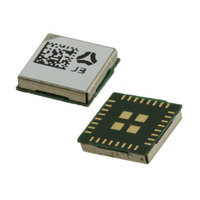J3,0000,00,3.5 Navman Wireless, J3,0000,00,3.5 Datasheet - Page 7

J3,0000,00,3.5
Manufacturer Part Number
J3,0000,00,3.5
Description
MODULE GPS RECEIVER JUPITER 3
Manufacturer
Navman Wireless
Specifications of J3,0000,00,3.5
Frequency
1.575GHz
Sensitivity
-159dBm
Data Rate - Maximum
38.4kbps
Modulation Or Protocol
GPS
Applications
GPS
Current - Receiving
34mA
Data Interface
PCB, Surface Mount
Antenna Connector
PCB, Surface Mount
Voltage - Supply
2.7 V ~ 3 V
Operating Temperature
-40°C ~ 85°C
Package / Case
Module
Lead Free Status / RoHS Status
Lead free / RoHS Compliant
Features
-
Memory Size
-
Other names
943-1010-1
Jupiter
3.5 Differential aiding
3.6 Core processor performance
The standard Jupiter
available from SiRF to customise the Jupiter
3.7 Sensitivity
Sensitivity of the Jupiter
3.8 Dynamic constraints
The Jupiter
• velocity: 500 m/s max
• acceleration: 4 G (39.2 m/s
• vehicle jerk: 5 m/s
• altitude: 18 000 m max (referenced to MSL)
switching between full power in tough GPS environments and low power in strong GPS signal areas. When signal
levels drop, the receiver returns to full power so that message output rates remain constant. This results in variable
power savings but much more reliable performance for a fixed output rate. Applications using ATP should give
performance very similar to full power, but with significant power savings in strong signal conditions. ATP is best
suited for applications that require solutions at a fixed rate as well as low power consumption and still maintain the
ability to track weak signals. With ATP at a 1 second update, a power saving of 50% can easily be achieved with
minimal degradation in navigation performance.
3.4.2 Push-To-Fix mode
Push-To-Fix mode always forces the GPS software to revert to a continuous sleep mode after a navigation position
fix. It will stay in sleep mode until woken by activation of the WAKEUP input , and compute a fresh position. If
the ephemeris data become invalid, the RTC has the ability to self activate and refresh the data, thus keeping the
restart TTFF very short. This mode yields the lowest power consumption of the module, and is ideal where a battery
powered application requires very few position fixes. For further information refer to the Low Power Operating Modes
application note, Navman NMEA reference manual and the SiRF Binary Protocol reference manual.
3.5.1 Differential GPS (DGPS)
RTCM DGPS is not available on the Jupiter
3.5.2 Satellite Based Augmentation Systems (SBAS)
The Jupiter
of SBAS. SBAS improves horizontal position accuracy by correcting GPS signal errors caused by ionospheric
disturbances, timing and satellite orbit errors. Refer to Table 14 for the default status on the Jupiter
3
receiver is programmed to deliberately suppress the output if the velocity and altitude limits are exceeded.
3
|
3
is capable of receiving WAAS and EGNOS differential corrections which are regional implementations
Datasheet
3
with GSW3 software runs at a CPU clock speed of 49 MHz. An SDK (Software Development Kit) is
3
Navman Wireless OEM Solutions • 27171 Burbank -Suite 200; Foothill Ranch, CA 92610-2501
TEL: +(949) 461-7150 • FAX: +(949) 461-7860 • www.navmanwirelessoem.com
3
is measured assuming a system noise value of 3 dB. The sensitivity values are as follows
max
Parameter
acquisition – cold start
acquisition – hot start
navigation
tracking
2
) max
3
firmware.
3
.
Table 2: Sensitivity
Signal Strength
–145 dBm
–155 dBm
–157 dBm
–159 dBm
15 dBHz
13 dBHz
11 dBHz
25 dbHz
C/N
0
3
.
5























